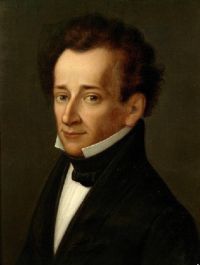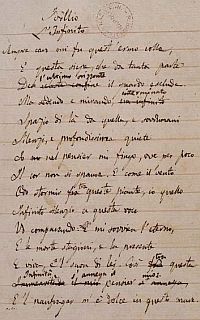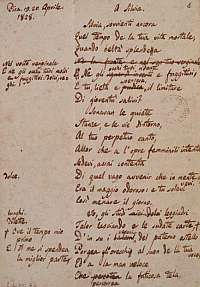



Giacomo Leopardi
Recanati 1798 - Napoli 1837
Bibliography: E. Carini, Bibliografia analitica leopardiana (1971-1980), Firenze 1986; E. Carini-A. Sbriccoli, Bibliografia analitica leopardiana (1981-1986), Firenze 1998; BIL: Bibliografia informatizzata leopardiana, 1815-1999: manuale d'uso ver. 1.0, a cura di S. Magherini, Firenze 2003; A. Tartaro, Leopardi, Giacomo, in Dizionario Biografico degli Italiani, vol. 64 (2005); G. Polizzi, Leopardi, Giacomo, in Il Contributo italiano alla storia del Pensiero - Filosofia (2012).
Studies on the library: A. Avoli, Monaldo e la sua biblioteca, in M. Leopardi, Autobiografia, Roma 1883, pp. 147-426; M. Leopardi, Della formazione ed accrescimento di questa Biblioteca, in Guida di Recanati, a cura di V. Spezioli, Recanati 1898, pp. 174-182; M. Porena, Un settennio di letture di Giacomo Leopardi, «Rivista d’Italia», XXV, 1922, pp. 68-83; F. Foschi, Intellettuali ed istituzioni culturali a Recanati dal XIII al XX secolo, «Il casanostra» XCIII, 1979-80, pp. 23-48; G. Landolfi Petrone, Filosofi del Settecento nelle letture di Leopardi, in Bibliothecae Selectae. Da Cusano a Leopardi, a cura di E. Canone, Firenze 1993, pp. 475-491; E. Benucci, La Biblioteca di Palazzo Leopardi a Recanati, «La fabbrica del libro», VII, 2001, (http://www.fondazionemondadori.it/cms/culturaeditoriale/238/20011); Ead., “Io gli studi talor lasciando e la sudate carte”. La Biblioteca di Palazzo Leopardi a Recanati, in Biblioteche nobiliari e circolazione del libro tra Settecento e Ottocento, a cura di G. Tortorelli, Bologna, 2002, pp.157-203; M. Balzano, Il selvaggio americano e le sue fonti nell’opera di Leopardi, «Rivista di Storia della Filosofia», LX , 2005, pp. 225-267; G. Polizzi-V. Sordoni, Uno scritto dimenticato del giovane Leopardi: la Disputatio e il suo rapporto con le Dissertazioni filosofiche, «Rivista di Storia della Filosofia», LXIV, 2009, pp. 653-708; Catalogo della biblioteca Leopardi in Recanati (1847-1899), nuova edizione a cura di A. Campana, Firenze, Olschki 2011, VIII-316 p.; Giacomo dei Libri. La Biblioteca Leopardi come spazio delle idee, a cura di F. Cacciapuoti, Milano, 2012, 351 p..
Online resources: